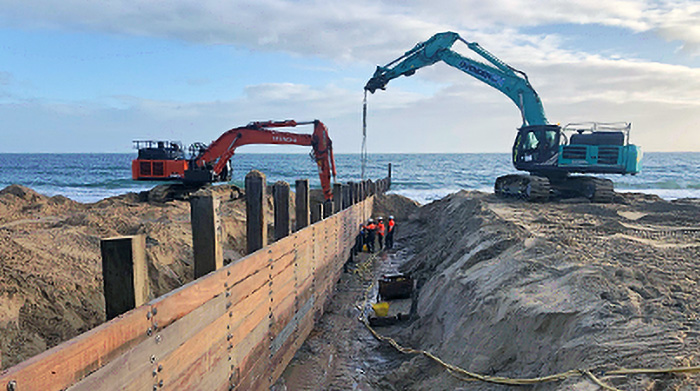
Poole Bay Sea Defences
Duration: Over two winters - 2020/21 and 2021/22
This project has followed on from our previous successful contract for BCP Council, completing reconstruction of 12 groynes on Southbourne Beach between 2017 and 2019. We were able to secure this second phase with a high-quality score in the tender process, based on previous experience and learning, whilst offering the client continued good value.
The project aim has been to renew coastal defences at Alum and Durley Chines, between Poole and Bournemouth, to provide ongoing protection of assets and property from coastal erosion and damage, and protect the sand beach as an amenity.
Suttle Projects were contracted to replace eight timber groynes, in accordance with BCP Council’s designs. These structures prevent the long shore drift of sand, thus protecting beaches from unwanted erosion.
The work, taking place over two winters, is part funded by the Environment Agency and was secured via a quality bid procurement regime. Through providing a high standard of management, Suttle Projects are able to bring the benefits of an SME to the client at a much-reduced cost, in comparison to competing national contractors. The work requires a highly skilled workforce and is dependent on a good understanding of tides and climatic conditions.
Bournemouth and Sandbanks seafronts are a heavily utilised public amenity, promoted as a major tourism asset. Many activities and events take place on the promenade and beach, and Suttle Projects have been required to consider these activities and plan around them during the construction.
Installation of the piles commences nearest to the promenade, working towards the sea. Each pile location is marked using a robotic total station and steel pins, with protective caps. A leader mounted auger drills down to an agreed depth. To a high degree of accuracy, piles are driven with a Movax attachment mounted on a 35-tonne excavator. This process had been meticulously considered to avoid causing later deflection of the installed pile line.
Each timber groyne consists of 17 rows of timber planking, made up of two different types of timber planks, usually Greenheart and Ekki. Each different type of timber has a unique position in the timber groyne structure.
Assembly of timber planks involves the use of a 24-tonne excavator, with modern fork attachments to minimise manual handling. Planks are clamped in position, as air operated specialist drills are utilised to drill each end of the timber plank and then coach screws are fastened.
As this process is repeated and the planks are installed deeper into the beach, heavy excavators are deployed to dig to deeper levels on the line of the piles, creating bunds to hold back the incoming tide and extend working periods. Outputs of up to 35 planks per shift are achieved in this way, delivering efficiency for the benefit of our client.



Good value, high quality materials and service